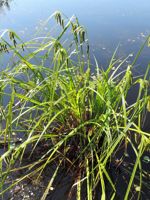Mon-Fri 9am - 5pm Mountain time
Beaked Sedge vs Cyperus-like Sedge
Carex utriculata
Carex pseudocyperus
CUSTOM GROW
CUSTOM GROW
Beaked Sedge is a native perennial wetland plant that forms dense clumps of tall, grass-like stems. It produces distinctive beaked seed heads that mature from late spring into summer. The plant provides food for waterfowl, muskrats, and other wildlife, while its dense growth offers cover for birds and small mammals. Its flowers and seed structures contribute to pollinator and invertebrate habitat in aquatic ecosystems.
Thriving in saturated soils and shallow water, Beaked Sedge is common in marshes, fens, and riparian zones. Its rhizomatous growth enables it to spread into large colonies that stabilize soils and support overall wetland health. Hardy and low-maintenance once established, it is well-suited to riparian plantings, naturalization, and ecological restoration projects.
Cyperus-like Sedge is a native perennial sedge found in wetlands, marshes, swamps, and along shorelines. Classified as an obligate wetland species, it grows in dense clumps that thrive in saturated soils, helping stabilize wet ground and protect shorelines. These colonies also provide cover for wildlife, while the seeds may be eaten by waterfowl and other birds. It is well-suited to wetland restoration, waterside and riparian zone plantings, and naturalization projects.
Its ornamental appeal comes from the contrast between the upright male floral spikes at the top of the stems and the long, drooping female floral spikes that hang below. These seed spikes resemble those of Cyperus species, giving the plant its common name and making it an attractive addition to naturalized plantings.

